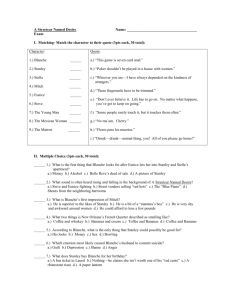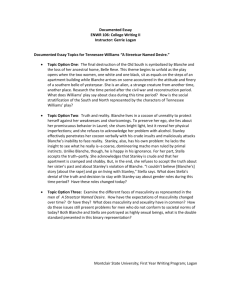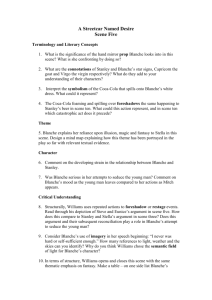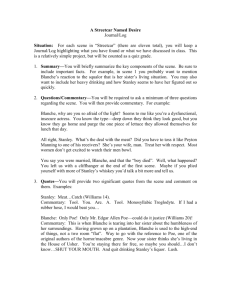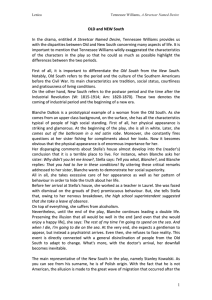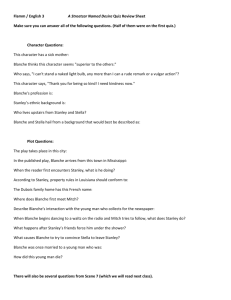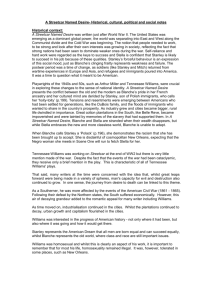File
advertisement
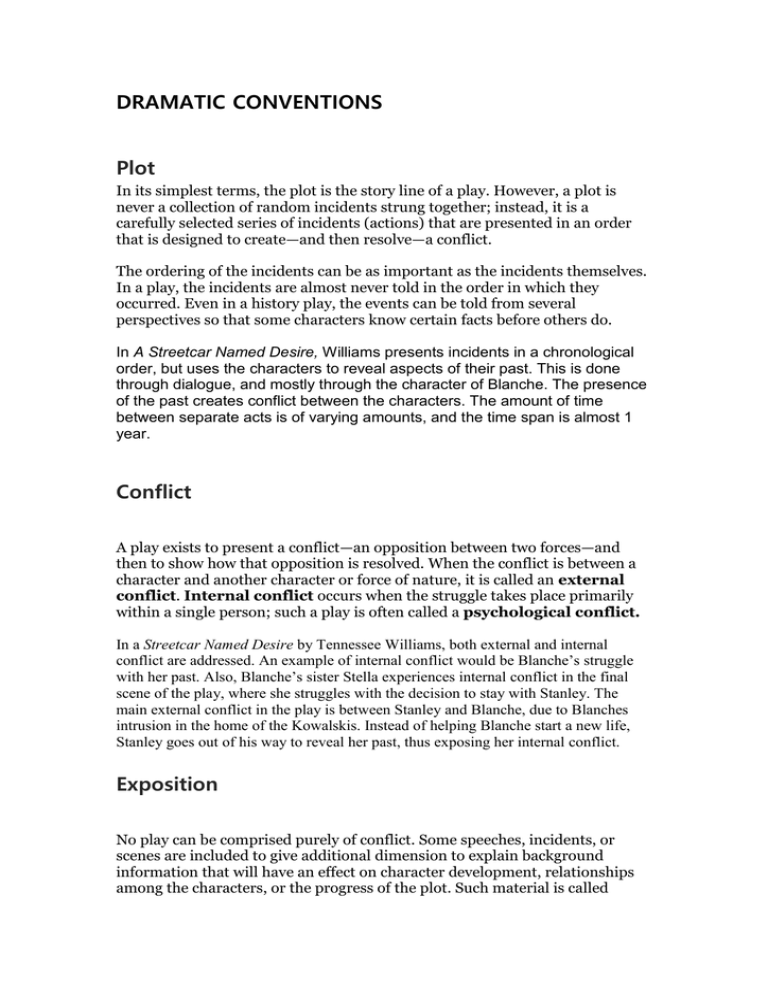
DRAMATIC CONVENTIONS Plot In its simplest terms, the plot is the story line of a play. However, a plot is never a collection of random incidents strung together; instead, it is a carefully selected series of incidents (actions) that are presented in an order that is designed to create—and then resolve—a conflict. The ordering of the incidents can be as important as the incidents themselves. In a play, the incidents are almost never told in the order in which they occurred. Even in a history play, the events can be told from several perspectives so that some characters know certain facts before others do. In A Streetcar Named Desire, Williams presents incidents in a chronological order, but uses the characters to reveal aspects of their past. This is done through dialogue, and mostly through the character of Blanche. The presence of the past creates conflict between the characters. The amount of time between separate acts is of varying amounts, and the time span is almost 1 year. Conflict A play exists to present a conflict—an opposition between two forces—and then to show how that opposition is resolved. When the conflict is between a character and another character or force of nature, it is called an external conflict. Internal conflict occurs when the struggle takes place primarily within a single person; such a play is often called a psychological conflict. In a Streetcar Named Desire by Tennessee Williams, both external and internal conflict are addressed. An example of internal conflict would be Blanche’s struggle with her past. Also, Blanche’s sister Stella experiences internal conflict in the final scene of the play, where she struggles with the decision to stay with Stanley. The main external conflict in the play is between Stanley and Blanche, due to Blanches intrusion in the home of the Kowalskis. Instead of helping Blanche start a new life, Stanley goes out of his way to reveal her past, thus exposing her internal conflict. Exposition No play can be comprised purely of conflict. Some speeches, incidents, or scenes are included to give additional dimension to explain background information that will have an effect on character development, relationships among the characters, or the progress of the plot. Such material is called exposition. In many earlier plays, from the classics of Greek drama through Shakespeare, a chorus or character gives an initial speech that is almost an orientation. In A Streetcar Named Desire, memories are used to clarify the factors leading to the current state of affairs. Through Blanche’s reminiscences, the audience learns of her past. The regular fights between Eunice and Steve, and the atmosphere of the poker nights illustrates how life was “normal” before Blanche’s arrival. The audience then understands how the woman’s arrival affects the neighborhood. Characters The main character in a play is called the protagonist; the opposing character is the antagonist. While the protagonist can be a hero, many—in fact, most—protagonists are far from heroic. Hamlet, for example, lacks the leadership qualities of a hero, but he is the protagonist in Shakespeare’s play. Similarly, the antagonist can have many positive qualities, but in the play, the antagonist’s role is to oppose the protagonist. Characters in a play are developed to different levels. Some are fully formed characters with an interior life; these are round characters. In contrast, flat characters have limited personalities and offer the audience little real interest. The role of a flat character is to participate in incidents that move the action forward or to behave in a predictable way that moves another character to change. When a character does grow or change, he or she is said to be a dynamic character; it is more likely that a round character will also be a dynamic character, but this is not a requirement. A flat character, by definition, is limited in the ability to change or grow. Thus most flat characters are also static characters, meaning that they stay the same, developmentally, throughout the play. In addition to round and flat characters and to dynamic and static characters, plays can also be peopled by stock characters. These are almost like a mass-produced item that is kept in stock in a store: you know exactly what you are buying. A stock character is a stereotype, manifesting universal characteristics. Thus, the dumb blonde could be a stock character, as could the belligerent cop, the whining brat, the prejudiced Southerner. Often, a stock, flat, or static character is used as a foil for a more highly developed character. In this case, the less developed character is used as a point of contrast in which a dynamic character’s growth is made more noticeable by the sameness of the foil. In A Streetcar Named Desire, Williams creates Blanche as the main character, creating conflict in the Kowalski household. Her presence on stage interferes with the dynamics of other characters by turning everyone against her in the end. Her appearance on stage immediately contrasts to her surroundings, highlighting that she does not fit in. Her deceitful character is revealed to the audience and gradually noticed by the other characters in the play, resulting in her downfall. Blanche’s past haunts her daily causing her day to day life to be affected. Stanley’s frustration towards Blanche gets in the way of his relationship not only between his wife, Stella, but also his friend, Mitch. Blanche intrudes Stanley’s personal life, challenging his authority which he could not take. Figurative language, or Imagery Figurative language, or figures of speech, includes such devices as metaphor. In a metaphor, a quality is ascribed to a character by tagging the character with a descriptor. Another figure of speech is the simile, in which a comparison is introduced by the words “like”, “as,” or “as if.” Figurative language is sometimes called imagery because it uses language to project an image. In A Streetcar Named Desire, Williams uses figurative language and imagery to characterize people and settings. The images provide a feeling of decay and mental instability to various scenes throughout the scene. The setting of Elysian Fields is described as "weathered" and "grey", which contrasts Blanche's appearance and her description of Belle Reve. Blanche is often associated with the color white, and also compared to a moth. The white represents her desire to put forth a pure, innocent image, which slowly falls apart. At the end of the play, she is wearing grey, which represents her failure to maintain this image in her sister's home. Her affiliation with the moth is also an indication of her character. Moths circle lights to find direction, and Blanche's aversion to the light represents how lost she is. Symbolism In A Streetcar Named Desire, Williams uses various symbols to characterize his main characters. One of the most prevalent motif throughought the play is the mention of the streetcars named Desire and Cementery. They are closely linked, and Blanche says that she takes Desire to reach Cementery, and then finally arrives at Elysian Fields. This is symbolic of her life, as her desire for her husband, Allen Grey, led to the death of the future she had envisioned. Finally, Elysian Fields, which is a mythological resting place, represents the state she wished to find in her sister's home. Although Blanche arrives at Elysian Fields hoping for rest, her past soon catches up with her, and she receives a bus ticket from Stanley. The bus, the modern equivalent of a streetcar, represents Blanche being forced to modernize. She cannot leave Elysian Fields on the streetcars she came in, as one cannot go backwards in life, but she also refuses to change with the times, leaving her with no place to turn except the asylum. Monologue A monologue is a sustained speech by a single character. In a monologue (or soliloquy), the character reveals something of his or her inner workings, allowing the audience or the reader to understand more about the character’s motivations, psychology, or constraints. Perhaps the most famous monologue is Hamlet’s soliloquy in Act III, Scene 1, which starts “To be, or not to be.” In A Streetcar Named Desire, Props Articles or objects that appear on stage during a play. In A Streetcar Named Desire, Blanche’s tiara made of rhinestones and her numerous other possessions symbolize how she is tries to deceive others into believing she is more than she is. Blanche’s paper lantern is meant to keep her out of direct light which is again another prop that acts veil from revealing the truth. Mitch’s cigarette case with the inscription which he shows Blanche conveys how he carries around a burden of loss as well. Staging The spectacle a play presents in performance, including the position of actors on stage, the scenic background, the props and costumes, and the lighting and sound effects. In A Streetcar Named Desire, The setting of Streetcar takes place in during the summer, Williams uses very colorful and descriptive language to bring to life the people of New Orleans. He focuses on human senses, using scents, colors, music and feelings to emphasize the dynamic nature of the city. The heat of the summer compliments the building tensions between Blanche and Stanley. Costumes Streetcar: When Blanche arrives she is wearing a white fluffy outfit, very similar to the outfit she wears when she leaves, the white symbolizing purity.
